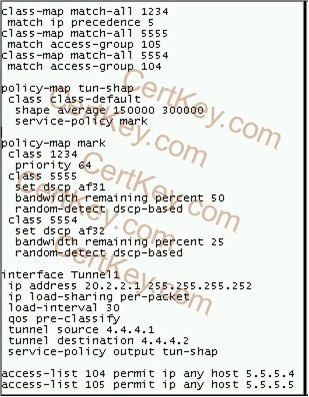Refer to the exhibit. When applying this hierarchical policy map on the on the tunnel1 interface, you measure high jitter for traffic going through class 1234. What is the most likely cause of this jitter?


A.
The configuration of a hierarchical policy map on a tunnel interface is not supported.
B.
Class 5555 and class 5554 are both taking up 100% of the bandwidth, leaving nothing for class 1234.
C.
The burst size for the traffic shaping is wrongly configured to 15000; this would require an interface capable of sending at 150Mb/s.
D.
The burst size for the traffic shaping has been wrongly configured; it should be set as low as possible.
E.
The burst size for the traffic shaping has been wrongly configured; it should be set as high as possible.
Explanation:
Network Jitter and Delay
Real-time voice communications are sensitive to delay and variation in packet arrival times.
Codecs require a steady, dependable stream of packets to provide reasonable playback
quality. Packets arriving too early, too late, or out of sequence result in jerky, jumbled
playback. This phenomenon is called jitter. Increasing jitter buffer size can help, but only to a point.
Because no network can guarantee a perfectly steady stream of packets under real-world
conditions, VoIP phones use jitter buffers to smooth out the kinks. A jitter buffer is simply a
First-In, First Out (FIFO) memory cache that collects the packets as they arrive, forwarding
them to the codec evenly spaced and in proper sequence for accurate playback.
While a jitter buffer can successfully mask mild delay and jitter problems, severe jitter can
overwhelm the jitter buffer, which results in packet loss (see below). Increasing the size of
the jitter buffer can help, but only to a point: A jitter buffer that increases overall round-trip
delay to 300 ms will make normal conversation difficult.
Packet Loss
As mentioned above, packet loss can be the result of the jitter buffer being overwhelmed.
Other reasons include landline media failure and poor wireless signal quality. The latter can
be a big problem with VoFi (Voice over WiFi) service. Regardless of the source, VoIP phones
and gateways attempt to conceal this type of signal degradation by duplicating packets to fill
in the missing data. As with jitter, these techniques can maintain voice quality only to a point.
Packet loss on data networks has long been characterized as a bursty phenomenon,
which is another way of saying it never rains, it pours. Networks tend to either sporadically
drop single packets (these periods are called gaps in packet loss), or large numbers of
contiguous packets in a burst. Packet loss concealment techniques typically have no
problem handling packet loss during gap periods; it is the sustained bursts you must watch
out for.

